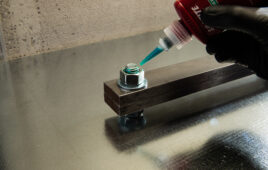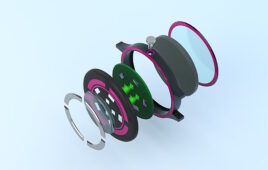Most are unlikely to guess that the world’s top adhesive producer began as a modest manufacturer of detergent. However, nearly a century-and-a-half ago, a young German salesman by the name of Fritz Henkel took a chance, producing soap.

Henkel’s Rocky Hill OEM lab. The company is celebrating 145 years in business. Click here to view a timeline, which includes Henkel’s major milestones over the decades.
He initially partnered with two associates to form, Henkel & Cie, in the city of Aachen in 1876. It was a wise decision. One of his associates had founded a water-glass factory about a year before the partnership, which was commonly used as a soap substitute during the American Civil War.
So, Henkel’s first product was a universal detergent based on silicate. Granted, that first product launch earned less than favorable results. But that failed to discourage the young founder…or much of anyone with the company since. Now, more than a century later, during a global pandemic, Henkel reported a little more than 19 billion euros in revenue for 2020.
“Talk about staying power, right?” says Doug Lescarbeau, Director Market Strategy, General Manufacturing & General Industrial Adhesives with Henkel Corporation. “The company is still here more than 140 years later…now with global operations in multiple sectors and more than 52,000 employees.”
Henkel has since established its niches in three main sectors (and, yes, it still produces soap), which include Laundry & Home Care, Beauty Care, and Adhesive Technologies.
“Interestingly, its entry into the adhesives market was simply out of need,” shares Lescarbeau. “Henkel initially required it to close the packaging of the soap powder box they were marketing.”
By 1922, the company founders realized they could also offer adhesives and sealants, as well as functional coatings, as part of Henkel’s retail offering. This entrepreneurial spirit is, perhaps, what’s been the company’s greatest success. It’s never shied away from experimenting with new products and R&D, developing new partnerships, or connecting globally and outside its current Dusseldorf headquarters. (Case in point: Henkel’s employees come from 125 different countries.)
Henkel has made several notable acquisitions over the years, including one major brand that’s well-known in the adhesives industry: Loctite.
In 1985, Henkel purchased about 25 percent of Loctite’s stock from the Krieble family founders and slowly added to it. More than a decade later, in 1997, it fully acquired Loctite, which has since become the largest adhesives brand, worldwide.
“Loctite also has an interesting history, which spans about 40 years,” he says. Lescarbeau has worked directly with the Loctite brand for more than 40 years. “It’s an American-born, father-son company that originated in Connecticut. But the company began almost by accident when the son developed a product that seemed to have no practical use in the marketplace. Then, on a visit back home, he showed his father, Vernon.”

Loctite, which was purchased by Henkel in 1997, is currently the largest, global adhesives company. It offers high-performance products designed to transform and simplify the assembly process for several applications.
According to Lescarbeau, Vernon Krieble was a chemistry professor at Trinity University in Harford. His son, Robert, who was also a chemist, worked as a development manager for General Electric. Robert had been working on a synthetic sealant, which he found to be anaerobic.
“As an anaerobic liquid, it would only solidify if deprived of oxygen,” explains Mike Shannahan, Market Manager with Henkel, who also works with the Loctite brand. “This intrigued Robert because the only way it could be sold to customers was if they would bubble oxygen through the material to prevent cure, which was not ideal.”
“His father said to him: ‘Bob, you’re trying to solve a chemical problem mechanically by bubbling air through it. You should try to solve it chemically,’” adds Lescarbeau.
That’s exactly what Vernon Krieble did. As a curious chemist, he took the liquid to his university lab to experiment with it. Eventually, he discovered that when it was applied to fasteners, it would flow into the crevices between the treads, harden, and lock them together.
The result: in 1953 the father-son team formed the American Sealants Company, which was later re-named the Loctite Corporation.
“At the time, this breakthrough — this locking capability for fasteners — was quite a radical idea. It generated quite a bit of interest in industrial sectors,” says Lescarbeau.
“The technology was definitely unique at the time,” Shannahan agrees. “What makes threadlocker so effective has to do with the cross-section of a nut and bolt in terms of the thread roots. It turns out, there’s only about 15 to 20% metal-to-metal contact there. The rest of that space is air. So, when a liquid threadlocker is applied, it fills those air spaces and cures as a thermoset plastic. It’s like a shim that fills in all of those air voids, locks the fasteners in place, and prevents corrosion.”
To this end, the Krieble’s learned something early on when first building their business. The real challenge was not in selling their new product invention. It was in educating potential customers.
“Some 60 years ago, I think they had a steep hill to climb, trying to convince an engineer to trust a chemical instead of a go-to lock washer,” says Shannahan. “But this focus on education is what continues to drive Loctite, now for its entire product portfolio, and even today as a brand of Henkel.”

Loctite recently launched an e-learning platform. Learn more here.
“For sure…our employees are educators as much as they are engineers or sales reps,” adds Lescarbeau. “That’s because nearly every designer or engineer out there thinks mechanically. But, we think differently. Every problem that we run into, we look at and solve chemically.”
Although most customers approaching Henkel are well aware of the Loctite brand. There’s still a misconception among some in the mechanical fastener industry about the properties of certain products, according to Shannahan.
“There are times when people won’t even consider using a threadlocker, for example, because they associate it with strength — and very high-strength, which is a blessing and curse at the same time,” he says. “I mean typically it’s a good thing, not to be able to pull fasteners apart. That’s what you want. But in certain applications, such as when you need to regularly service a piece of equipment, you might want to remove the fasteners with greater ease than applying heat to the assembly.”
A high-strength threadlocker is typically considered a permanent bonding solution but it is possible to remove without breaking the fasteners by using extremely high temperatures. Or, as Shannahan points out, there are other options, including different strengths of threadlocker available. And, some are more “removable” than others.
“They’re all labeled. We have red, which is high-strength, blue, which is a medium-strength, and purple for lower-strength bonds. Then, there are a variety of other options beyond this,” he explains. “This is where our technical support and training comes in.”
Before the pandemic, the Loctite team routinely offered in-person training seminars but that moved online last year.

Doug Lescarbeau
“It’s turned out really well. It seems many companies took advantage of the fact their engineers were working remotely to encourage virtual learning and training sessions,” says Lescarbeau. “And I have to say how quickly and impressively Henkel was able to adapt, including for its employees. From the start of the pandemic, management ensured we felt safe and secure in terms of our jobs, which was incredible given everything going on.”
Perhaps this is no surprise. A company that’s been around for 145 years is used to overcoming challenges. Plus, a glance at its Ranking & Awards web page will tell you that it’s “among the most admired companies in Germany” and that it was ranked as one of North America’s best employers by Forbes for three years straight. And this year, for 2021, Forbes named Henkel as one of America’s best employers for diversity.
Then, there are the product innovations. For example, Henkel recently launched a unique, instant component bonding product (LOCTITE 402) that’s CMR-free and represents the top properties of the company’s top-performing products. This adhesive offers high shear strengths and a temperature resistance that exceeds the current 121° C | 250° F maximum. Henkel also added the industry’s first bio-based, polyurethane-reactive, hot-melt adhesive to the market (LOCTITE HHD 3544F), which is designed for consumer electronics assembly.

Mike Shannahan
Aside from electronics, it also offers products for automotive, metal processing, construction, craftsmen, and packaging. In fact, in 2018, Henkel invested some $130 million euros building its global Innovation Center for Adhesive Technologies in Düsseldorf, where about 350 experts work to develop and advance new adhesive technologies.
The goal: “To improve the cross-team collaboration and knowledge exchange among our employees within a state-of-the-art and inspiring work environment.” This was according to Jan-Dirk Auris, a Henkel Board member for the Adhesive Technologies business. The building also serves as an interactive customer center, which has been temporarily put on hold because of COVID-19.
“Henkel is highly invested in R&D, which makes it a rewarding place to work as it encourages problem-solving and innovation in a supportive environment,” says Lescarbeau. “There’s space to learn and develop new ideas.”
It’s been noted that founder, Fritz Henkel, was extremely committed to the social welfare and wellbeing of his employees. A quote that’s attributed to him: “A business is only a good business if everyone involved enjoys it.” Clearly, Henkel is a good business.





Tell Us What You Think!